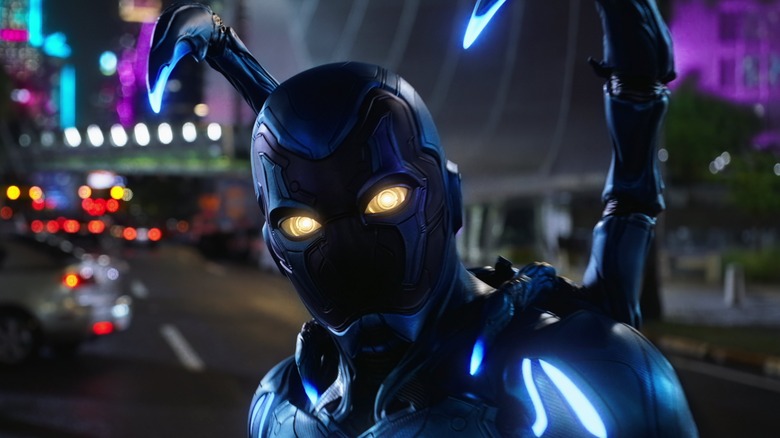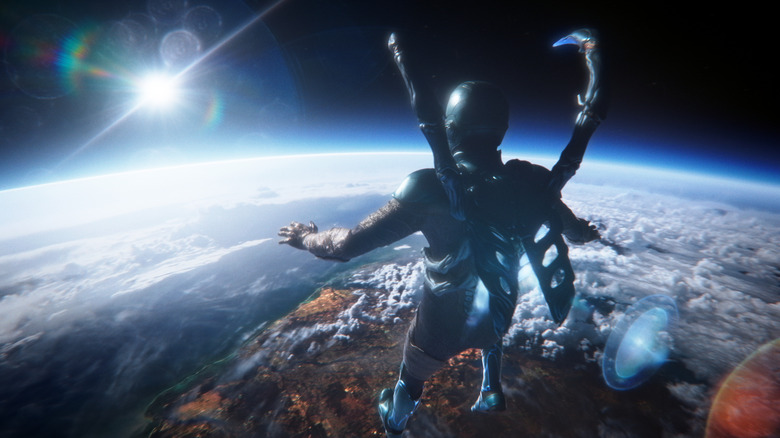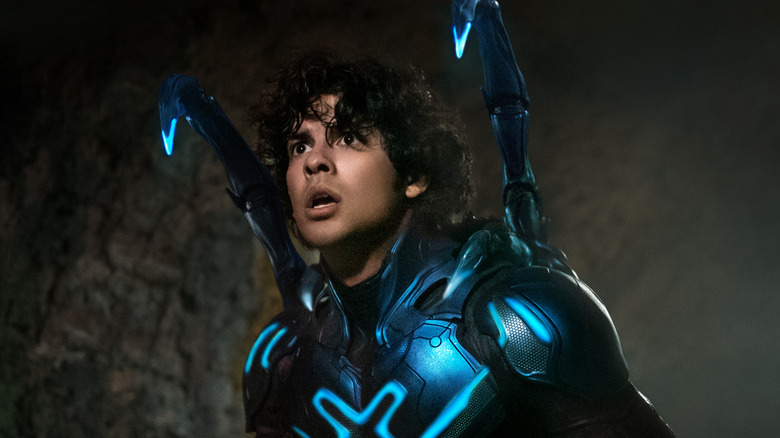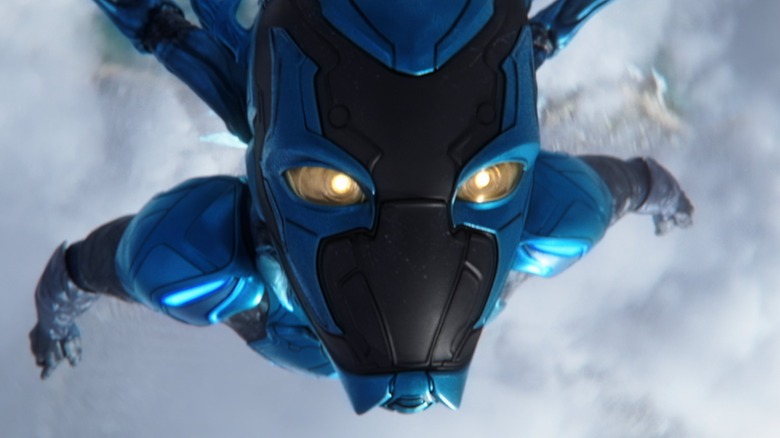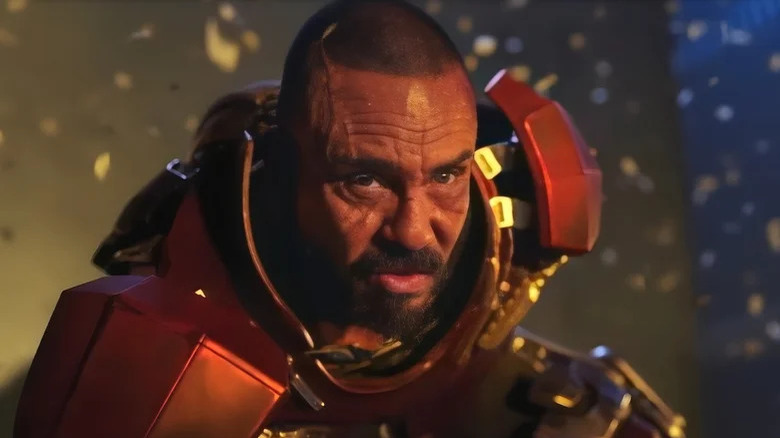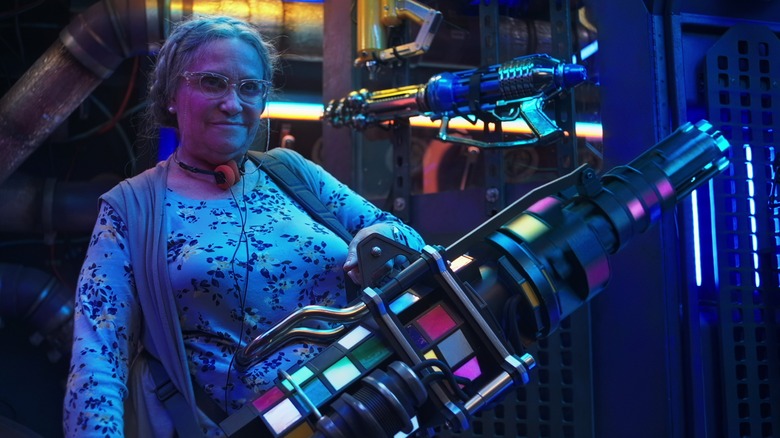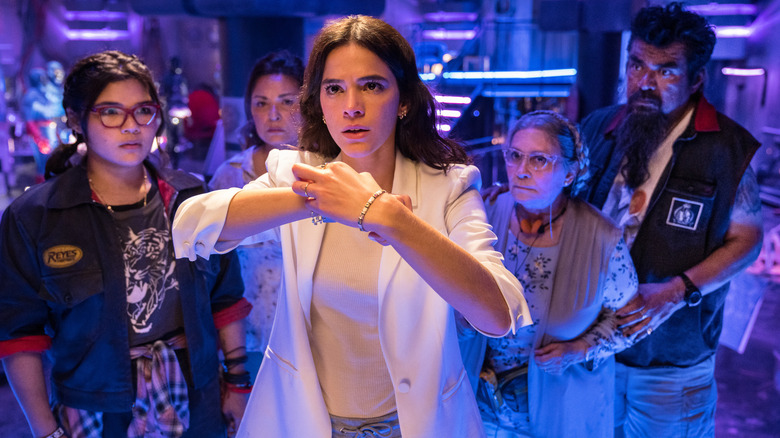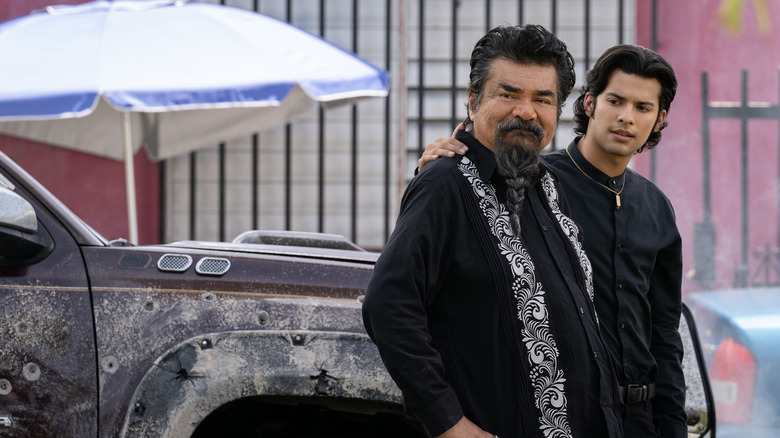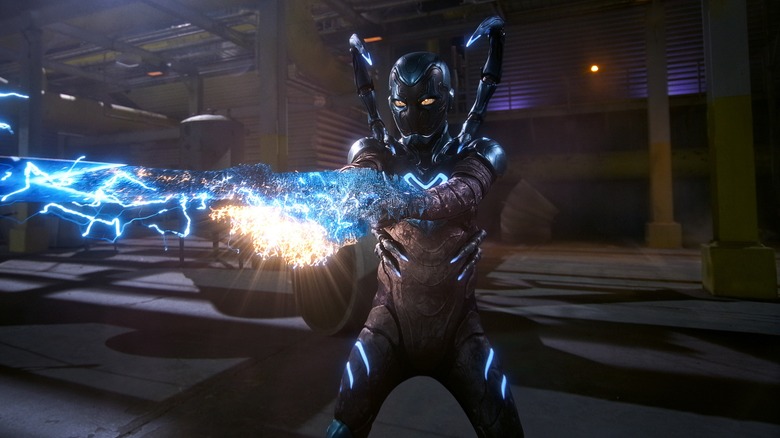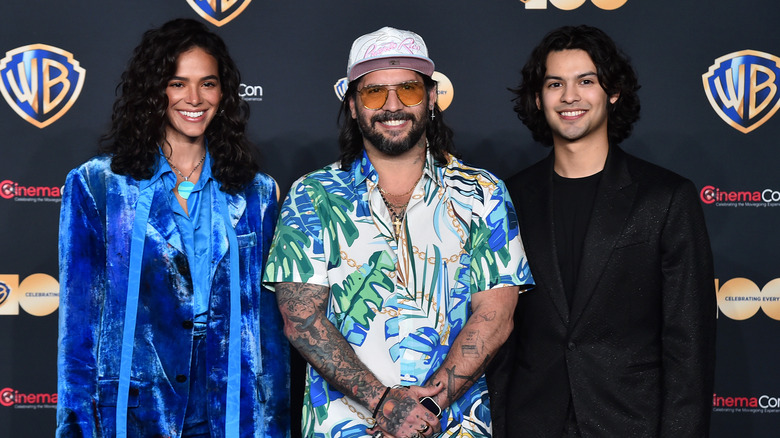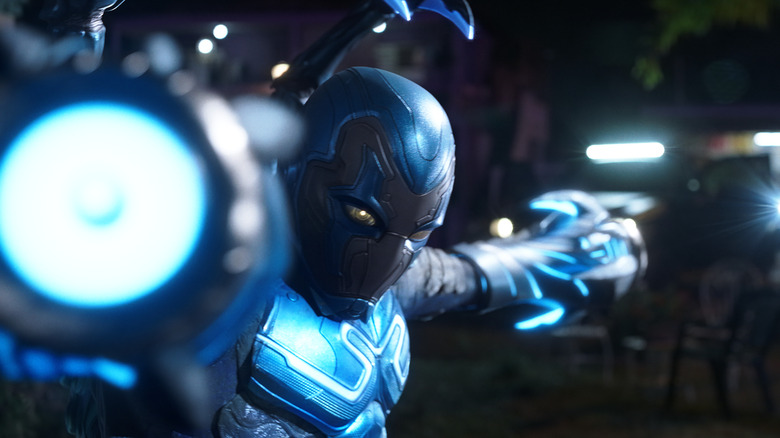The Ending Of Blue Beetle Explained
Contains spoilers for "Blue Beetle"
Superhero movies have gotten so bogged down by the weight of franchise planning that it can be hard to remember what they used to look like. "Blue Beetle" remembers the old days — the time when comic book movies could just be fun adventures with simple but powerful messages. Thanks to some fantastic direction from Ángel Manuel Soto, a superb leading performance from "Cobra Kai" star Xolo Maridueña, and a stellar supporting ensemble, "Blue Beetle" is a triumph.
If you're sick of multiverses, time travel, tie-ins, cameos, and all the other baggage that comes with modern superhero movies, you'll be relieved by the simple joy at the heart of "Blue Beetle." It follows a winning formula: A bright, brave young protagonist stumbles into extraordinary circumstances, struggles to accept his new responsibility, but ultimately becomes the hero he needs to be.
One of the great things about "Blue Beetle" is that the hero's family has a leading role, too. This enjoyable DC flick is just as much about community and support as it is about individual heroism. The third act makes for an epic, chaotic, and satisfying finale, setting up a potential sequel and establishing Jaime Reyes as one of the most interesting movie superheroes currently working. Here's what you need to know about the ending of "Blue Beetle."
What you need to remember about the plot of Blue Beetle
One of the main strengths of "Blue Beetle" is its pacing. Unlike a lot of blockbusters these days, it didn't reveal every major story beat in the trailers, and it doesn't overload viewers with too much exposition at the top. The first act moves pretty slowly to its benefit, with Jaime returning home after graduating college and discovering that his family isn't doing so great. His father (Damián Alcázar) is recovering from a heart attack, the family business has gone under, and they're about to lose their house.
Jaime struggles to find a decent job to help his family financially, but he catches a break when he encounters Jenny Kord (Bruna Marquezine), niece of Kord Industries leader — and truly evil cartoon villain — Victoria Kord (Susan Sarandon). Victoria is trying to use an advanced piece of alien technology known as the Scarab to create dangerous weapons for private policing and military purposes. Jenny steals the Scarab to prevent this and gives it to Jaime for safekeeping, but it doesn't take long for the artifact to bond with his body and mind, turning him into the Blue Beetle.
With the help of Uncle Rudy (George Lopez), Jaime and Jenny sneak into Kord Industries, battle Victoria's lieutenant Carapax (Raoul Max Trujillo) and steal a key to Jenny's father's old superhero lair. While the trio tries to get the Scarab out of Jaime, Victoria sends her soldiers to the Reyes house to draw him out, leading to his capture and the death of his father. Undeterred, the Reyes family pulls together and sets out to rescue Jaime from Victoria's heavily fortified island base.
What happens at the end of Blue Beetle?
The third act of "Blue Beetle" is a full-blown assault on Victoria Kord's island fortress. Jenny leads the Reyes family back to her father's secret base, where they discover and power up the Bug — a large, armored, scarab-shaped vehicle capable of flight. The Bug comes fully equipped with an arsenal of gadgets and laser weapons, so the whole crew — even Nana (Adriana Barraza) — gears up to bring Jaime home.
With Rudy at the wheel, they crash the gates and start rampaging. The Bug proves to be more than a match for Victoria's security forces. Jenny and Jaime's sister Milagro (Belissa Escobedo) infiltrate the compound to plant explosives and cut the power. Meanwhile, Victoria tries to transfer the Scarab's code from Jaime into Carapax so that his O.M.A.C. suit can finally reach full power. This process completes, but Jaime escapes and reunites with his family. After the Scarab reboots, he re-enters the compound to save Jenny and his sister with a little help from Nana and Rudy.
It all comes down to a one-on-one duel between Jaime and Carapax, with our hero ultimately coming out the victor. At first, he wants to kill Carapax to avenge his father's death, but the Scarab shows him his enemy's tragic backstory — how he was taken by Victoria as a child soldier in Guatemala and forced to do her bidding. Jaime lets Carapax live, and he returns the favor by killing Victoria and destroying the compound, sacrificing himself to wipe all O.M.A.C. research from the planet. Back home, the family mourns Alberto, and Jenny and Jaime kiss.
Jaime's cosmic dream sequence
One of the more confusing moments during the ending of "Blue Beetle" is the cosmic dream sequence that Jaime has while strapped into Victoria's device. It's also one of the film's most powerful and beautiful scenes. Knocked unconscious by the toll of the procedure, Jaime awakens in a technicolor version of his family home, where he's greeted by his father. Though Jaime couldn't have possibly known for sure that his dad was dead, he realizes it here, and the two share a touching goodbye. Alberto tells his son that it's his destiny to use his new powers for good. As he does, the house is stripped away, revealing an open void around them and a giant avatar of the Blue Beetle.
So what's actually happening here? Is it simply a hallucination from a man on the brink of death? Or is there something more supernatural going on? At this point, the Scarab is bonded to Jaime's brain, which could have some effect on his subconscious. Or maybe there's magic involved. In the comics, the Scarab's original mission of conquering Earth is layered because it's changed by magical forces. "Blue Beetle" does spend much time explaining its version of Khaji-Da (Becky G), the sentience within the device, so a similar power could still be at play. Regardless, it's a great moment, underscored by Bobby Krlic's triumphant soundtrack.
Carapax has a change of heart
Though Victoria Kord is the main villain of "Blue Beetle," Carapax is the muscle. Known as Indestructible Man in the comics, he's the one who actually battles Jaime throughout the movie. But by the end of "Blue Beetle," Carapax has had a change of heart.
After Khaji-Da shows Jaime Carapax's tragic past, he lets him go. Carapax then overheats his suit, destroying Victoria's entire facility, all of her O.M.A.C. prototypes and research, her, and himself. Without the montage of flashbacks that we get of Carapax's life, this twist might feel a bit sudden. But "Blue Beetle" shows us exactly how much he's been made to sacrifice. While just a child, his home was destroyed and his mother was killed in a bombing raid — presumably part of the "anti-communist, counter-terrorist" operations Kord Industries funded in Guatemala. He was made a child soldier in Victoria's private army and sent to war against his own people, all so that she could establish a local mining operation.
We see these mines advertised in one of Victoria's corporate videos, making it clear that any political agenda was just a ruse for corporate imperialism. His whole life, Carapax has been a tool of that ambition, with Victoria slowly replacing his wounded body with mechanical augmentations to keep him going. It's implied that these procedures suppressed Carapax's memories, but his connection to the Scarab brings them back. His prior claim that Jaime's love of family is a weakness is revealed to be a lie he was forced to tell himself.
Down with the imperialists!
Though its tone is often campy and goofy, evoking early 2000s superhero movies like the Sam Raimi "Spider-Man" trilogy, "Blue Beetle" also deals with some serious themes. Beyond the core messages about family, bravery, and perseverance, there's an underlying condemnation of corporate imperialism and the privatization of the military and police.
Carapax's backstory is a big part of that. His past demonstrates how Global North governments and corporations have historically destabilized and decimated areas of the Global South for profit. Victoria claims that her military operations in Guatemala were meant to stop dangerous terrorist groups, but her company's mines tell the real story. This breed of corporate imperialism is also visible in Jaime's neighborhood, where houses owned by Kord Industries get jacked-up rent to push out the local Latino community so gentrification can take place. Private police — a rising trend in America today — patrol and oppress lower-income residents with impunity. They break down doors and intimidate people with military-grade weapons, all with the mission of extorting them for more monetary gain.
Above all else, "Blue Beetle" is a fun action-adventure movie. It doesn't spend too much time zooming in on these larger social issues. But they're there if you look for them, and the end of the movie is a cathartic bit of revenge. When Nana guns down a whole platoon of Kord soldiers with a laser Gatling gun and shouts "Down with the imperialists" in Spanish, she's speaking for far more than just herself.
Family is the real superpower
It's obvious from the get-go that "Blue Beetle" is a film about family. Jaime is the main character, but every member of the Reyes clan plays a big role. Without Rudy, they never would have been able to get a Ted Watch from Kord Industries. Without the guidance of his father, Jaime wouldn't become the hero he does. And without the combined efforts of everyone else, he might never have escaped from Victoria.
Carapax tells Jaime repeatedly that the love he feels for his family makes him weak. Of course, he proves that to be false. It's a story Carapax carries with him to endure the pain of losing his own family, though he still carries around a picture of his mother in a locket she used to wear. Only after his memories — all of his love and grief — come back does Carapax fully become himself again.
Director Ángel Manuel Soto has said that centering the family was important to him from the start, and that he didn't find it believable that a Latinx superhero could keep such a big secret from his family. "The experience that we wanted to show was that family is our superpower to some extent," Soto told Den of Geek. "When we're in trouble, the first people we call are our parents. It was about being able to hone into that and try something new."
The new Kord Industries
With Victoria Kord presumably blown to smithereens at the end of "Blue Beetle," Jenny takes over as the new head of Kord Industries. It's clear that she intends to make some major changes, starting with an end to the company's long history of military weapons development. She also tells the Reyes family that she intends to give the Keys back to the Latinx community to whom it actually belongs, ending the corporate dictatorship and private policing practices that Victoria used to oppress the neighborhood.
Is this a bit of an oversimplification of how corporate oversight and property control actually work? Yes. The idea of Kord Industries becoming a "good" tech company overnight, even with all of the larger implications of its business, feels a bit like a fairy tale ending. But after everything that Jaime and his family go through, maybe that's what they deserve. Regardless, Jenny will surely be a big improvement over her aunt. A new day has dawned on Palmera City, it seems.
The hero of Palmera City
By the end of "Blue Beetle," Jaime Reyes is a bonafide hero. He's put a stop to an evil corporate imperialist and prevented her from crafting dangerous weapons that could further harm communities like his. And, according to the final shots of the movie, Jaime isn't really trying to hide his new superhero identity.
Though he doesn't mean to, he activates the Scarab's exoskeleton while chatting with Jenny in broad daylight in front of his house. He then takes her with him for a little flight around town. Since his whole family knows about the Scarab, and since he's clearly not trying to hide it from the neighbors, Jaime might not be a secret for long. Most of DC's biggest heroes like the Flash, Superman, Batman, and Wonder Woman all have secret identities, but Jaime appears to be taking the Tony Stark route.
Hopefully, Palmera City welcomes him. It's obvious that Jaime can do a lot of good for his community and the city at large, and with Kord Industries now being run by Jenny, the leading power in Palmera is on his side, as well. At one point in the movie, Rudy compares the last Blue Beetle — Jenny's father Ted Kord — to Superman in Metropolis or the Flash in Central City. Jaime seems destined to become that sort of protector for his hometown, which was created specifically for the movie to give him that opportunity. In the comics, Jaime is from El Paso, Texas.
Is Ted Kord really still alive?
The mid-credits scene at the end of "Blue Beetle" reveals that Ted Kord may actually be alive. We're shown his Batcave-esque secret lair, filled with his old Blue Beetle suits and various gadgets, but no one's manning the tech. Then, out of nowhere, a message starts to play over the speakers. We hear a man's voice, coated in static, declare that he is Ted Kord and that he's still alive. He begs whoever receives the message to tell his daughter. No clear picture of Ted appears on the screen, however, leaving the whole scene somewhat mysterious.
It's pretty clear that Ted's return is meant to set up a "Blue Beetle" sequel. But where has he been all this time? Why is he only now reaching out to Jenny? And is it actually him, or could it be some kind of ruse? Unless another "Blue Beetle" movie comes out and clears things up, all of these questions will remain unanswered. Still, it's fun to imagine multiple generations of Blue Beetle teaming up in a sequel — Jaime with his Scarab exoskeleton, and Ted with his treasure trove of goofy, retro gadgets.
What has the cast and crew of Blue Beetle said about the ending?
Speaking with Den of Geek, director Ángel Manuel Soto explained that he didn't want Jaime to be a Superman-level hero by the end of "Blue Beetle." Instead, the story is more about him accepting the responsibility and growing with his family beside him. "I didn't want it to be another story where 15 minutes in, something happens, and 50 minutes later, he's dominating the experience, and by the end, he's saving the world," Soto said. "He's not going to save the world yet; he doesn't deserve to yet."
Given the cliffhanger in the mid-credits scene, it's pretty clear that Soto has big plans should the movie spawn a sequel. And thankfully, star Xolo Maridueña is ready for that possibility. "I want to do 12 more years of 'Blue Beetle,'" the young actor said in an interview with Entertainment Weekly. He confirmed that he's spoken with DCU heads James Gunn and Peter Safran about where Jaime and his family could go in the future as the larger franchise develops.
"I'm excited to see what they have in mind and how Blue Beetle and the rest of his family might loop into the rest," Maridueña said. "But my heart is already so fulfilled with this movie. If we do 20 of these movies and 40 cameos or if it's just this one, what's most exciting to me is the opportunity for people to see it and have little kids everywhere saying, 'Oh my gosh, this guy looks like me. I can be a hero, too.'"
What the end of Blue Beetle could mean for the franchise
"Blue Beetle" is one of the best DC movies in years, so it's good to know that the characters will likely be sticking around for a while. It's been a weird stretch for the franchise with the DCEU timeline ending and the DCU kicking off under James Gunn. A lot of fans have been confused about what characters and storylines are part of the new universe and which ones will be left behind. Some of those questions still haven't gotten answers, but Gunn himself has confirmed that Blue Beetle is part of the vision for the new DCU.
"The first DCU character for sure is Blue Beetle," Gunn said on the podcast Inside of You with Michael Rosenbaum, "and the first full DCU movie is 'Superman [Legacy].'" That's a bit of a cryptic sentiment, but what Gunn probably means is that even though "Blue Beetle" was conceived before the DCU revolution, it fits into the new plan. His wording also implies that the studio isn't yet fully certain of how many past characters will come back.
Whatever role Jaime will end up playing in the future of the franchise, director Ángel Manuel Soto is ready for it. "We are part of the plans that they have been creating for the future installments of the DCU," the director told Total Film. "Our first movie, the way we wanted to do it, was always with the mentality that we wanted to do two more, at least," Soto continued. "And taking the traditional three-act structure of a story, we wanted our first movie to practically be the first act of a saga."
